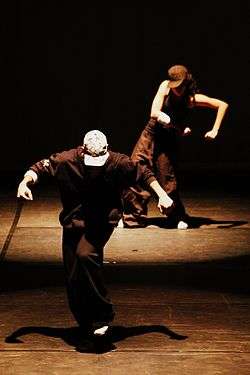Street dance
A street dance is a dance style that evolved outside dance studios in any available open space such as streets, dance parties, block parties, parks, school yards, raves, and nightclubs. A street dance is a vernacular dance in an urban context.[1] Vernacular dances are often improvisational and social in nature, encouraging interaction and contact with spectators and other dancers. These dances are a part of the vernacular culture of the geographical area that they come from. Examples of street dance include b-boying (or breakdancing), which originated in New York City.[2]

Street dance is an umbrella term for a large number of social dance styles. Social dance styles have many accompanying steps and foundations, created organically from a culture, a moment in time, a way of life, influenced by natural social interaction.[3]
Clogging, which evolved in the streets and factories of Northern England in the mid-19th century, is an early form of street dance.[4]
See also
- List of street and vernacular dances
- List of ethnic, regional, and folk dances sorted by origin
References
- Stearns, Marshall Window; Stearns, Jean (1994). Jazz Dance: The Story of English and American Vernacular Dance. New York City: Da Capo Press. ISBN 0306805537.
- Mansbach, Adam (24 May 2009). "The ascent of hip-hop: A historical, cultural, and aesthetic study of b-boying". Boston.com. Retrieved 18 September 2010.
- "Street Dance Classes Harlow". 16 June 2020. Retrieved 16 June 2020.
- Hickling, Alfred (2 December 2010). "Clog dancing's big street revival". The Guardian. Retrieved 1 December 2019.
External links

| Look up street dance in Wiktionary, the free dictionary. |